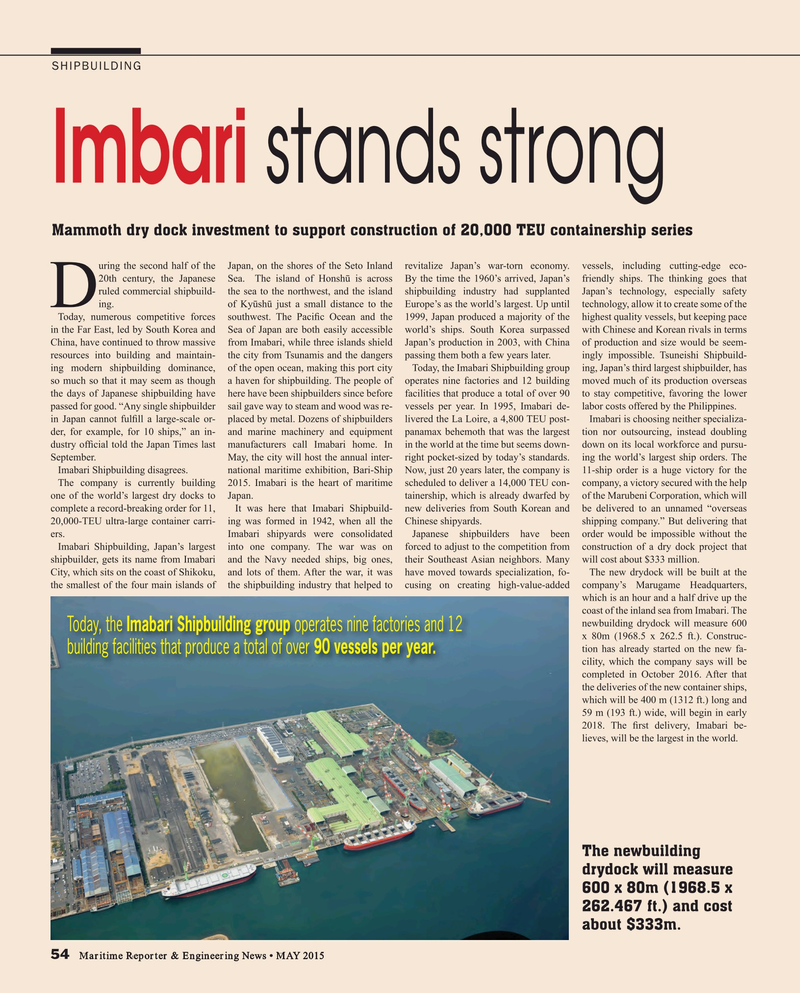
Page 54: of Maritime Reporter Magazine (May 2015)
The Marine Propulsion Edition
Read this page in Pdf, Flash or Html5 edition of May 2015 Maritime Reporter Magazine
SHIPBUILDING
Imbari stands strong
Mammoth dry dock investment to support construction of 20,000 TEU containership series uring the second half of the Japan, on the shores of the Seto Inland revitalize Japan’s war-torn economy. vessels, including cutting-edge eco- 20th century, the Japanese Sea. The island of Honshu is across By the time the 1960’s arrived, Japan’s friendly ships. The thinking goes that ruled commercial shipbuild- the sea to the northwest, and the island shipbuilding industry had supplanted Japan’s technology, especially safety
Ding. of Kyushu just a small distance to the Europe’s as the world’s largest. Up until technology, allow it to create some of the
Today, numerous competitive forces southwest. The Paci? c Ocean and the 1999, Japan produced a majority of the highest quality vessels, but keeping pace in the Far East, led by South Korea and Sea of Japan are both easily accessible world’s ships. South Korea surpassed with Chinese and Korean rivals in terms
China, have continued to throw massive from Imabari, while three islands shield Japan’s production in 2003, with China of production and size would be seem- resources into building and maintain- the city from Tsunamis and the dangers passing them both a few years later. ingly impossible. Tsuneishi Shipbuild- ing modern shipbuilding dominance, of the open ocean, making this port city Today, the Imabari Shipbuilding group ing, Japan’s third largest shipbuilder, has so much so that it may seem as though a haven for shipbuilding. The people of operates nine factories and 12 building moved much of its production overseas the days of Japanese shipbuilding have here have been shipbuilders since before facilities that produce a total of over 90 to stay competitive, favoring the lower passed for good. “Any single shipbuilder sail gave way to steam and wood was re- vessels per year. In 1995, Imabari de- labor costs offered by the Philippines. in Japan cannot ful? ll a large-scale or- placed by metal. Dozens of shipbuilders livered the La Loire, a 4,800 TEU post- Imabari is choosing neither specializa- der, for example, for 10 ships,” an in- and marine machinery and equipment panamax behemoth that was the largest tion nor outsourcing, instead doubling dustry of? cial told the Japan Times last manufacturers call Imabari home. In in the world at the time but seems down- down on its local workforce and pursu-
September. May, the city will host the annual inter- right pocket-sized by today’s standards. ing the world’s largest ship orders. The
Imabari Shipbuilding disagrees. national maritime exhibition, Bari-Ship Now, just 20 years later, the company is 11-ship order is a huge victory for the
The company is currently building 2015. Imabari is the heart of maritime scheduled to deliver a 14,000 TEU con- company, a victory secured with the help one of the world’s largest dry docks to Japan. tainership, which is already dwarfed by of the Marubeni Corporation, which will complete a record-breaking order for 11, It was here that Imabari Shipbuild- new deliveries from South Korean and be delivered to an unnamed “overseas 20,000-TEU ultra-large container carri- ing was formed in 1942, when all the Chinese shipyards. shipping company.” But delivering that ers. Imabari shipyards were consolidated Japanese shipbuilders have been order would be impossible without the
Imabari Shipbuilding, Japan’s largest into one company. The war was on forced to adjust to the competition from construction of a dry dock project that shipbuilder, gets its name from Imabari and the Navy needed ships, big ones, their Southeast Asian neighbors. Many will cost about $333 million.
City, which sits on the coast of Shikoku, and lots of them. After the war, it was have moved towards specialization, fo- The new drydock will be built at the the smallest of the four main islands of the shipbuilding industry that helped to cusing on creating high-value-added company’s Marugame Headquarters, which is an hour and a half drive up the coast of the inland sea from Imabari. The newbuilding drydock will measure 600
Today, the Imabari Shipbuilding group operates nine factories and 12 x 80m (1968.5 x 262.5 ft.). Construc- tion has already started on the new fa- building facilities that produce a total of over 90 vessels per year. cility, which the company says will be completed in October 2016. After that the deliveries of the new container ships, which will be 400 m (1312 ft.) long and 59 m (193 ft.) wide, will begin in early 2018. The ? rst delivery, Imabari be- lieves, will be the largest in the world.
The newbuilding drydock will measure 600 x 80m (1968.5 x 262.467 ft.) and cost about $333m.
54 Maritime Reporter & Engineering News • MAY 2015
MR #5 (50-57).indd 54 MR #5 (50-57).indd 54 5/1/2015 10:17:51 AM5/1/2015 10:17:51 AM

 53
53

 55
55
